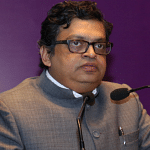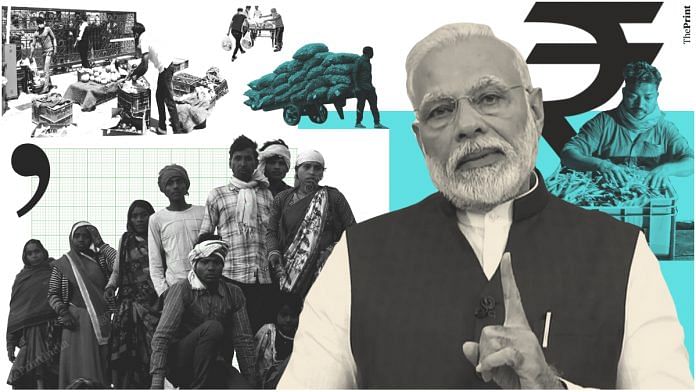PM Narendra Modi, in his national address Tuesday, said the Covid-19 crisis has taught India the importance of local manufacturing and supply chains. “It is time to be vocal about local,” he said. Modi talked about the the importance of ‘atma-nirbharta’ (self-reliance) and announced a Rs 20 lakh crore package. Other measures on the table are tax sops, strict non-tariff barriers to discourage imports and domestic goods procurement.
ThePrint asks: Vocal for local: Can India afford self-reliance or is it a slogan to please swadeshi lobby?
PM Modi’s push for self-reliance was a long time coming. Time to revive local industries and create jobs
 Ashwani Mahajan
Ashwani Mahajan
National co-convener of Swadeshi Jagaran Manch
Call for using local goods is not about pleasing anybody. It is time we revive local industries — from Kanchipuram sarees to Made-in-India PPE masks.
In the last 70 years, we have not trusted our indigenous industries, resources and entrepreneurs. We did not trust ourselves. From 1950 onwards, we allowed development to take place through the public sector but when that failed, we took the route of globalisation after 1991. We handed the baton over to Foreign Direct Investments (FDI), multinational corporations and foreigners. This new system was capital-based. Monopolisation and capturing markets was priority. The growth that happened was jobless, faceless and ruthless. By allowing the import of subsidised Chinese goods, we invited job losses and economic inequalities within our own border, put several local industries out of business and made people dependent on government doles, instead of nurturing them into valuable contributors to society.
PM Narendra Modi’s push for self-reliance was a long time coming. It is time to revive those local industries that were taken for granted. It is time to usher in economic policies that produce welfare, sustainable incomes, help job creation and all in all, puts faith in the people. The sad state of our social sectors is also due to the lack of public expenditure on health and education, which is a side effect of the withdrawal of government from social sector, and handing over these welfare-enhancing sectors to private profiteers.
Modi’s emphasis on self-reliance is just another costless catchphrase, which will be forgotten soon
 Arjun Jayadev
Arjun Jayadev
Professor of Economics at the School of Arts and Sciences, Azim Premji University
We need to see Modi’s 8 pm addresses for what they are: set pieces of political messaging that are less about considered policy trajectories and more about managing a particular moment. It is unclear why the slogan of self-reliance was resurrected during this latest episode, but it seems at the moment just that — a slogan. Whether this was to assuage the concerns over labour ‘reforms’ or buttressing a sense of embattlement, or some other reason, is not clear.
That said, the Covid crisis has shown that there may indeed be ways in which some degree of self-reliance should be supported and expanded. Clearly, food self-sufficiency has come back into focus given both facts on the ground right now and the low rank for India on global hunger indices even prior to crisis.
Similarly, India has been the ‘pharmacy of the developing world’, ensuring our own public health and of others. But the last two decades have seen us adopting IP rules that are choking our industries. There is space for creative thinking and resolute policy in which to make global integration more fit to purpose—but there is clearly no systemic thinking about this. Tuesday’s statement is likely to be a costless catchphrase which, like others in the past, will be forgotten soon.
Make-in-India rhetoric can add political mileage, but Modi should avoid the mistakes of Indira Gandhi
 Narendar Pani
Narendar Pani
Professor, National Institute of Advanced Studies
At a time when the lack of sufficient test kits, and the import of some faulty ones, has prevented India from stepping up Covid-19 testing, there is bound to be some political mileage to be gained from slogans of self-reliance. By tapping into this reservoir, Prime Minister Modi was also building on his favourite imagery of India being an all-powerful nation that fears no one, man or virus. But if this were to be taken beyond the realm of sloganeering, and into the domain of policy, the country will have a very heavy price to pay.
This is a price we have paid before. Prime Minister Modi’s words were eerily similar to those repeatedly used by Indira Gandhi. The high protectionist wall Indira Gandhi built made Indian exports extremely uncompetitive, leading to a foreign exchange crisis that brought the country to the verge of not being able to pay for its oil imports. The high foreign exchange reserves may seem like a substantial buffer, but if the failure to compete leads to an exodus of foreign capital, the reserves can deplete quickly.
The Make-in-India rhetoric may have its uses when the country is facing a crisis, but the prime minister should avoid the mistakes of Indira Gandhi.
Govt has taken care of challenges faced by MSMEs, will uplift small contractors, real estate sector
 Gopal Krishna Agarwal
Gopal Krishna Agarwal
National spokesperson, BJP (Economic Affairs)
I welcome the announcement particularly because Prime Minister Narendra Modi mentioned Micro, Small and Medium Enterprises — MSME — and Non-Banking Financial Company — NBFC — sectors. It shows that the government has taken care of the challenges faced by these sectors.
The RBI’s measures on infusing liquidity front alone were not helping them, because banks were risk averse to extend credit. The Modi government has announced collateral-free loans — with 100 per cent government-backed guarantee — worth Rs 3 lakh crore for MSMEs in addition to Rs 20,000 crore for stressed MSMEs and Rs 50,000 crore equity infusion through Fund of Funds. This is path-breaking because the government will share the credit risk for this sector.
For NBFCs and micro-finance companies, the government has arranged a Rs 75,000 crore package for buying commercial papers. The initial Rs 30,000 crore with full government guarantee will help infuse liquidity into this sector and the remaining Rs 45,000 crore will be used to cover borrowings with 20 per cent guarantee given by the government. They can further finance other smaller businesses and retailers.
The government’s policies also address the issue of extension of contracts and force majeure. This will help reduce litigation and uplift smaller projects, contractors and real estate. Other compliance issues of taxation have also been taken care of.
Even the definition of ‘micro’ ‘small’ and ‘medium’ is being reworked, which will ensure that the MSME continues to get benefits.
Also read: How can Modi govt revive economic activity when CMs want migrant workers to return home?
By Pia Krishnankutty, journalist at ThePrint




Like VOCAL FOR LOCAL, I think it is important to also have VISUAL FOR LOCAL. Like products have green and red dots, we should start having saffron dot for MADE IN INDIA so that consumers are aware what they are buying. This will promote local products. The dot can also be a PI chart depicting the percentage of the product MADE IN INDIA. Today even though consumers intend to buy products MADE IN INDIA the information is not prominent or easily readable. The PIE chart also keeps reminding us that we need to do more to complete the circle. I totally agree with you that we have punchured our own boat and we cannot abruptly stop Chinese products as we are still not there. But we can definitely increase awareness and promote local manufacturers by this visual symbol.
Fraud !! A total fraud !! First,, people were dragged out of their house in demonetization drama…now people have been kept confined in their house and this govt. is doing fraudulent activities only.Where is the job? What is the action to bring price rise down ? How the thugs and Kalabazaris will be controlled ? How to fed these unfortunate migrant workers? All rubbish talk!!!Doctors /Nurses are without any supportive materials to treat patient…..people are running from hospital to hospital for treatment..migrants are being killed like street dogs….aur yeh log saab AC room me baith kar lecture de rahe hain.Foreign goggles…foreign watch…BMW car…aam admi ki baat karta hain ? Nonsense!!!
Compared to Afganistan, some African countries the Indian efficiency i better that makes India proud, but suggest aim higher asap beforeyouloose the train.
India with same population as China is i/5 th of Chinese economy, The German output is no less than 7 times of India. Yet the Indians are unable to guide their resources to obtain more turnover. Why ? I rather not answer to avoid unpopularity.
Niti Aayog has been working on Make in India for six years. Manufacturing and exports are in a funk. Actually we cannot be self reliant even in terms of savings and foreign exchange. The kindness of strangers keeps us afloat. It required vision and courage in 1978 for China – still a communist country – to stand orthodoxy on its head and to start the greatest economic miracle the world has seen. Now reflected in the 5 : 1 asymmetry it has gained over India. No one could possibly be more self reliant than the poor, trudging wearily home along the highways. One understands better now the depth and ferocity of religious belief in India. Without it, …